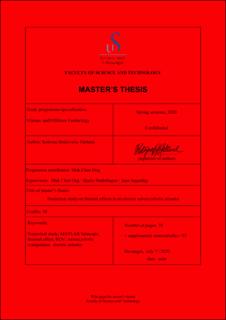| dc.contributor.advisor | Ong, Muk Chen | |
| dc.contributor.advisor | Nedrehagen, Bjarte | |
| dc.contributor.advisor | Sagarduy, Juan | |
| dc.contributor.author | Fjetland, Kotryna Bedrovaite | |
| dc.date.accessioned | 2020-10-16T08:17:03Z | |
| dc.date.available | 2020-10-16T08:17:03Z | |
| dc.date.issued | 2020-07-07 | |
| dc.identifier.uri | https://hdl.handle.net/11250/2683240 | |
| dc.description | Master's thesis in Offshore Technology | en_US |
| dc.description.abstract | A remotely operated vehicle (ROV) is equipped with two robotic manipulators. Current manipulators are hydraulically actuated. The industry has uncovered the potential in replacing hydraulic-based technology with its electrical counterpart. As a benefit of using electrical actuators, the accuracy in manipulator motion (and thus efficiency) is dramatically improved. Furthermore, precise power regulation and positioning increase safety in ROV operations.
Undesired behaviors caused by inadequate controls or poor design may occur in new technology. With high currents and torque, overheating in the electric actuator poses a real risk. Elevated temperatures may result in a system failure that could lead to a hazardous situation, such as destruction of subsea structures and equipment. In order to minimize such hazards, agile simulations based on underlying physical laws are an effective methodology.
This master’s thesis aims to investigate thermal effects compromising the operation of a shoulder joint of an electric-driven manipulator. The temperature of several key components (motor, gear, fluid, housing, controller, brake, and DC-DC converter) is studied, along with heat transfer between them. Robotic manipulator duty cycles for subsea vehicles are investigated to point out which of these has the most detrimental effect on the joint operation.
A thermal model is developed with MathWorks software for the purpose of the investigation. The model is built based on two iterations, where the second model concludes the research. It is concluded that the temperature does not trespass the allowed temperature set at 85 °C. Through a parameter sensitivity analysis on the first iteration, the main findings indicate that the thermal transfer coefficient and the surrounding temperature has the most noticeable effect on actuator temperature. | en_US |
| dc.language.iso | eng | en_US |
| dc.publisher | University of Stavanger, Norway | en_US |
| dc.relation.ispartofseries | Masteroppgave/UIS-TN-IMBM/2020; | |
| dc.rights | Navngivelse 4.0 Internasjonal | * |
| dc.rights | Attribution-NonCommercial-NoDerivatives 4.0 Internasjonal | * |
| dc.rights.uri | http://creativecommons.org/licenses/by-nc-nd/4.0/deed.no | * |
| dc.subject | offshore teknologi | en_US |
| dc.subject | marine technology | en_US |
| dc.subject | offshore technology | en_US |
| dc.subject | undervannsteknologi | en_US |
| dc.title | Numerical study on thermal effects in an electric subsea robotic actuator | en_US |
| dc.type | Master thesis | en_US |
| dc.subject.nsi | VDP::Teknologi: 500::Marin teknologi: 580::Offshoreteknologi: 581 | en_US |

